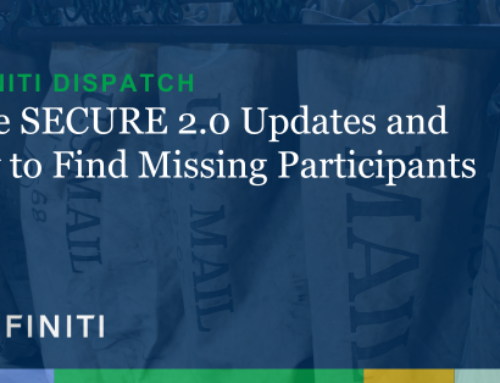VOL 6: COVID Relief Provisions
Recent COVID-19 relief legislation contains numerous provisions affecting business owners, but the most significant element for plan sponsors impacted by the pandemic may be the temporary rule preventing partial plan terminations. The Coronavirus pandemic has brought uncertainty and turmoil for businesses. Many businesses were forced to lay off large portions of their staff, which in many cases, in a normal plan year, would result in a partial plan termination.
What is a partial plan termination?
A partial plan termination is a facts and circumstances determination that occurs where a significant portion of the plan’s active participants are no longer employed. As a general rule, the IRS has stipulated that a more than 20% reduction in the number of covered participants during a plan year is presumed to be a partial plan termination.
This generally includes any severance from employment other than a severance that is on account of death, disability or retirement on or after normal retirement age. It also includes events outside of the employer’s control, such as depressed economic conditions related to a global pandemic.
The presumption of a partial termination happens when the turnover rate is 20% or greater. The turnover rate is determined by dividing the number of eligible employees who had an employer-initiated severance from employment during the applicable period by the sum of all eligible employees at the start of the applicable period and any newly eligible employees during the applicable period. The applicable period is a plan year, or a longer period if there are a series of related severances from employment.
If the plan sponsor can provide evidence that the turnover rate was not the result of employer-initiated severance from employment and the severance was purely voluntary, the IRS may find that there was no partial termination. This type of evidence may include information from personnel files, employee statements or other corporate records. The employer may also provide evidence that the turnover rate is routine.
What happens if your plan has a partial plan termination?
“Affected participants” are immediately 100% vested in their accounts. Section 411(d)(3) of the Internal Revenue Code (the “Code”) and Section 1.411(d)-2(a) of the Treasury Regulations (the “Regulations”) require that upon a plan’s termination or partial termination, the benefits accrued to date of such termination or partial termination, to the extent funded, are fully vested for each affected employee.
“Affected employee” is not defined in the Code or Regulations. However, in Revenue Procedure 2007-43, the IRS provided the following guidance:
If a partial termination occurs on account of turnover during an applicable period, all participating employees who had a severance from employment during the period must be fully vested in their accrued benefits, to the extent funded on that date, or in the amounts credited to their accounts.
A literal reading of this Revenue Procedure would indicate that those who terminated voluntarily, although not counted in the calculation of a partial plan termination, would be considered “affected employees,” and would have their vesting accelerated. A plan sponsor could take a more narrow approach, but should consider engaging ERISA counsel to review the facts and circumstances.
What if a business has regular turnover?
Routine turnover during the year is generally not considered a partial termination. Factors relevant to determining whether the turnover rate is routine include:
- information on the turnover rate in other periods and the extent to which terminated employees were actually replaced,
- whether the new employees performed the same functions,
- whether the new employees had the same job classification or title, and
- whether the new employees received comparable compensation.
If the employer cannot provide sufficient evidence to show that the turnover rate was routine or was not the result of employer-initiated severance from employment, the presumption of a partial termination will stand and the affected participants, including those who voluntarily terminated during the applicable period, must be fully vested.
How did recent legislation affect partial plan terminations?
The Consolidated Appropriations Act, 2021 (the “Act”), which was signed into law on December 27, 2020, includes a temporary rule preventing certain partial plan terminations. Specifically, the Act states:
A plan shall not be treated as having a partial termination within the meaning of 411(d)(3) of the Internal Revenue Code of 1986 during any plan year which includes the period beginning on March 13, 2020, and ending on March 31, 2021, if the number of active participants covered by the plan on March 31, 2021 is at least 80 percent of the number of active participants covered by the plan on March 13, 2020.
Essentially, the Act gives employers until March 31, 2021 to rehire laid off or furloughed workers (or hire replacement workers who would be eligible for the plan no later than March 31, 2021), at a level of at least 80% that it was in the plan on March 13, 2020, to avoid a partial plan termination.
This relief is not just available for calendar-year plans. The intention of the provision is to provide relief for any plan year which includes the period beginning on March 13, 2020, and ending on March 31, 2021, and to allow an employer to wait until March 31, 2021 to determine whether there had been a partial plan termination for 2020.
Does a plan have to rehire the same individuals who were laid off?
No. The new relief is based on 80% of the “active participants.” However, the plan’s eligibility requirements will be important in this case, as new hires may not be eligible for the plan to be considered active participants by March 31, 2021.
—
 Brooke Cozort is an ERISA Attorney with significant experience working on ERISA matters and qualified plans. She provides guidance on plan design considerations, operational compliance, fiduciary responsibilities, legislative and regulatory changes and industry trends.
Brooke Cozort is an ERISA Attorney with significant experience working on ERISA matters and qualified plans. She provides guidance on plan design considerations, operational compliance, fiduciary responsibilities, legislative and regulatory changes and industry trends.
BROOKE K. COZORT, JD CPC
ERISA Attorney | brooke.cozort@definiti-llc.com
This material has been prepared for informational purposes only, and is not intended to provide legal, tax, or investment advice. Any tax-related discussion contained in this material is not intended or written to be used, and cannot be used, for (i) avoiding any tax penalties, or (ii) promoting, marketing, or recommending to any other party any transaction or matter addressed herein. This material does not provide fiduciary recommendations concerning investments or investment management; it is not individualized to the needs of any specific benefit plan or retirement investor, nor is it directed to any recipient in connection with a specific investment or investment management decision. Please consult your independent legal counsel and/or professional tax advisor regarding any legal or tax issues raised in this material.
—





